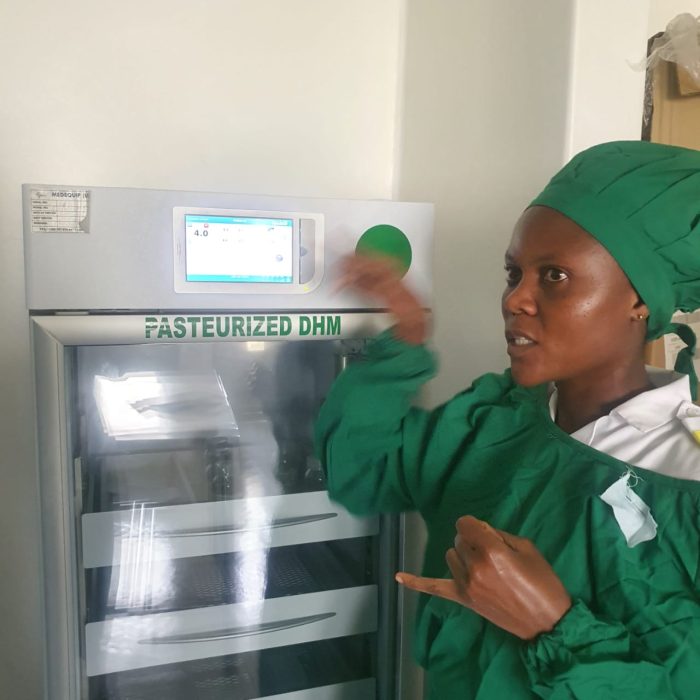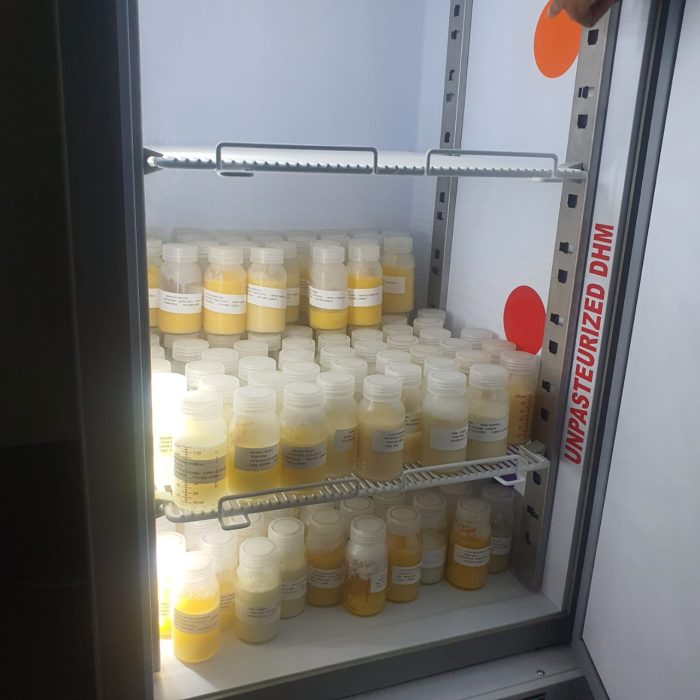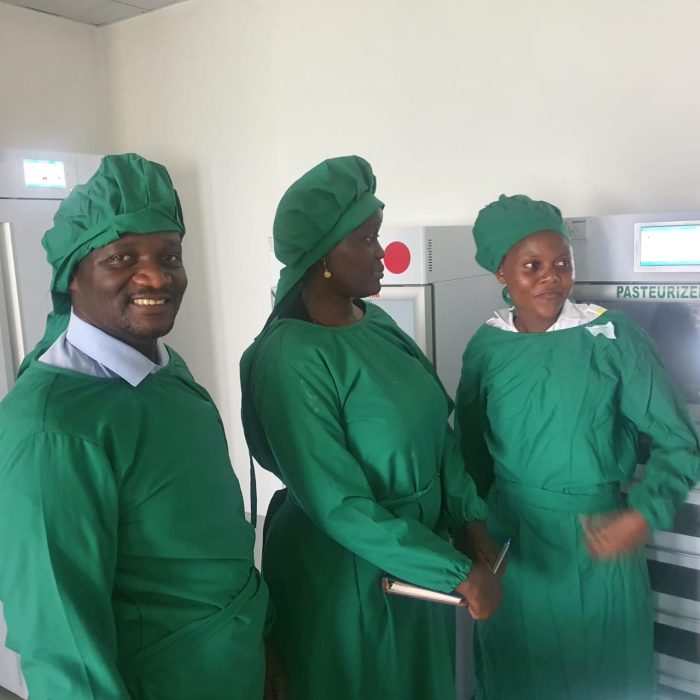
A visiting team from Makerere University School of Public Health, led by Dr. Monica Okuga the project coordinator of the Uganda Newborn Programme and a research fellow in the Department of Health Policy, Planning, and Management at the School of Public Health, had the opportunity to tour the human breast milk bank at Nsambya Hospital.
The Uganda Newborn Programme (UNP) is an investment funded by the Elma Philanthropies and involving a consortium of four partners (Makerere University School of Public Health, Baylor Uganda, Adara Uganda, and Nsambya hospital) together with the Ministry of Health to consolidate and replicate the most effective newborn interventions in 20 districts in three regions of Uganda (Western, Kampala, and North-Central). The overall goal is to reduce neonatal mortality by 40% in the target hospitals.
With support from ELMA philanthropies, Nsambya Hospital has successfully instituted a breast milk bank. This is a huge step in the critical management of preterm and infants whose mothers cannot produce milk and more especially now that Ministry of Health is planning to scale up Newborn Care Units countrywide. Therefore, the visit was aimed at documenting the learnings about the initiation, progress, successes and bottlenecks of the breast milk bank. These learnings will provide insights to scaling up of this practice countrywide.



During the visit, the team learned about the processes involved in collecting, pasteurizing, storing and distributing human breast milk to premature and sick infants in need. They had an opportunity to interact with Dr. Victoria Nakibuuka, a neonatologist at Nsambya Hospital who leads the pediatric unit; and other staff at the bank and witnessed firsthand the impact that the availability of breast milk has had on the health and development of vulnerable babies.
Dr. Nakibuuka revealed that there has been a big change and shift towards breast milk use because of the human milk bank and the trainings done with aid of learning materials like videos, documentaries, and information leaflets. She said that breast milk is highly comprehensive- ‘a complete food’, but unfortunately, it has not been adequately promoted in our settings due to a insufficient understanding of the importance of breast milk. She also emphasized that the more one comprehends breast milk, the more effectively one can promote it. The availability of human breast milk has had a significant impact on the growth and development of premature and sick infants who require it. She believes that it is a game-changer for them.
Launched last year in November 2021, the milk bank aims to provide a ready supply of “safe pasteurized human breast milk” donated for preterm babies and neonates whose mothers may be unable to provide adequate breast milk.
During the interaction, Dr. Nakubuuka noted that the ethics related to donor human breast milk primarily concerns vulnerable babies, particularly preterm infants. These are the categories that should receive donor milk and should be in a hospital setting. While the babies are fed on donor milk, the mothers are taught how to stimulate breast milk production to feed their babies. “By the time the mother leaves here, we should have taught her the methods to improve breast milk production.” added Dr. Nakibuuka.
The presence of a human breast milk bank improves breast milk production, as mothers are educated through videos and documentaries on breast milk donation during their antenatal and postnatal periods.
At the Nsambya milk bank, a mother has to undergo certain procedures before she is allowed to donate milk. Likewise, the milk undergoes certain processes before it is given to a baby. At the facility, most of the donors are postnatal mothers who have just delivered. The human milk donors give undergo health education, consenting procedures and a thorough screening process prior to donation. Blood is screened for HIV, Hepatitis B and other infections. This process aims to ensure that the donor is healthy, not on any regular medication, and produces an adequate amount of milk to meet her own baby’s needs before donating to the milk bank. On passing the screening tests, the donors then express milk using electrical milk pumps. This milk is collected in glass bottles and pasteurized at 68.5 0C to kill bacteria and viruses. Rapid cooling of the milk to 4 0C then occurs after which the milk is stored in a special freezer at -18 0C. When donor milk is required, it is removed from the freezer, thawed and stored in an ordinary fridge at 40C. There are strict quality control measures taken to ensure that the donor milk is safe before use. After pasteurization, a sample is taken for culture and if bacteria are found, the whole batch is discarded. Pasteurized donor human milk is donated human breast milk that has been heated at specific temperatures to kill contaminants but preserve its nutritional value and can safely be given to babies in need.
According to Dr. Nakibuuka, since the commencement of the year, the human breast milk repository has provided sustenance to approximately thirty-five neonates. This exemplifies the invaluable contribution of breast milk banks in providing optimal nutrition to infants, particularly those who are unable to receive milk directly from their mothers due to medical reasons.
The pasteurization of donated breast milk results in a nutrient-rich and antibody-rich resource that can aid in the growth and development of premature, low birth weight, or medically fragile infants. The significance of these resources in supporting neonatal health highlights the importance of raising awareness regarding the benefits of breast milk donation and the indispensable role of milk banks in ensuring the provision of this vital resource to all infants
Currently, the team at Nsambya hospital is developing a lactation manual which will go long way in equipping health workers with the correct knowledge and skills to help mothers improve the lactation experience. There are also plans underway to expand the human breast milk bank it to other facilities like Naguru, Mengo, Lubaga and Kibuli Hospitals.
The team not only visited the human breast milk bank but also visited the baby Unit and the Neonatal Intensive Care Unit (NICU). Notably, Nsambya hospital has a ‘special’ transportation model for high risk babies from the theatre or labour suite to the NICU. This special transporter is a baby cot mounted with oxygen, pulse oximeter, Neopuff (maintains air pressure) and a Warmilu blanket with an insta warmer to keep the baby warm.
Dr. Okuga expressed her appreciation for the work being done at the bank and emphasized the importance of increasing awareness of breast milk promoting neonatal development and growth. The visit concluded with a commitment from both the visiting team and the hospital staff to continue working together towards the goal of contributing to reduction of neonatal mortality.
Written by Judith Grace Amoit.
